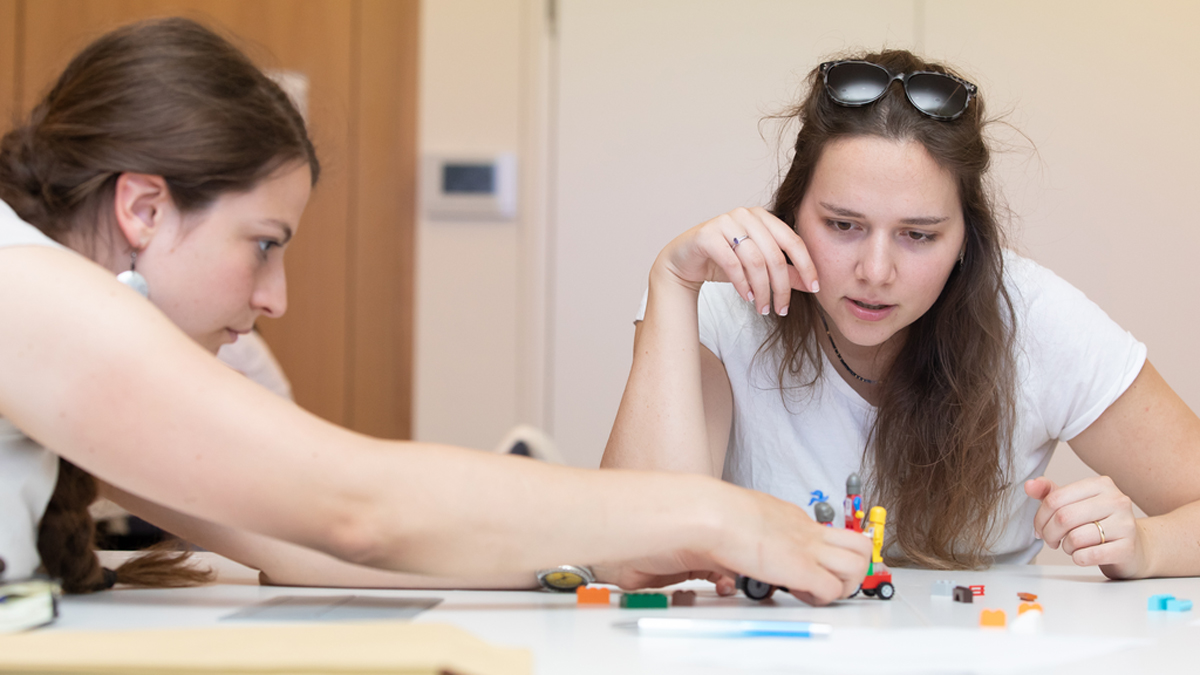
© Jens Lehmkühler
Orientation in the Sea of Data
On the “Research Data Day,” the U Bremen Research Alliance sought to increase awareness about the proper handling of data for the benefit of research and society.
Without data, there would be no progress in science. But how is this saved, shared, and made accessible or reusable so that new discoveries can be made?
Four to five students and young researchers sit at each of four tables. On each table is a package of Legos, with which the teams are to build a vehicle, while documenting each step of the build. When this is finished, they disassemble the vehicle and swap tables. Their next task is to rebuild the other group’s vehicle using only the documentation left behind.
“Bremen is leading the way.”
“How to document your research data – Keep calm and play with Lego®” was the title of this workshop at Fraunhofer MEVIS, one of the member institutes of the U Bremen Research Alliance. “We want to use this playful approach to increase interest in data documentation,” said Heike Thoricht from the Data Science Center of the University of Bremen, who supervised the workshop with her colleague Sandra Zänkert.
Workshops, walk-ins, lectures, panel discussions – almost two dozen events, distributed across ten venues, informed about the different aspects of data handling on the Research Data Day around the University of Bremen’s campus. Various fields and institutes participated with a common motto: “Open doors for open data.” All events were open to the public and free of charge.
The kick-off event took place on the evening before in the House of Science in Bremen’s city center with several renowned speakers and a top-notch team. Professor Dr. Jutta Günther, President of the University of Bremen and head of the U Bremen Research Alliance, set the tone for the event in front of 100 guests. Research data is one of the most important intangible resources of our time, she maintained, this is the “gold of the present.” In order to uncover this potential for new understanding, data must be made accessible so that others can easily find it. “This necessitates an appropriate infrastructure,” Günther said and referred to the “Nationale Forschungsdateninfrastruktur” (National Research Data Infrastructure, NFDI) funded by the federal government. “I am proud to say that the institutes of the U Bremen Research Alliance are involved in nine of the 27 consortia. Bremen is leading the way.”
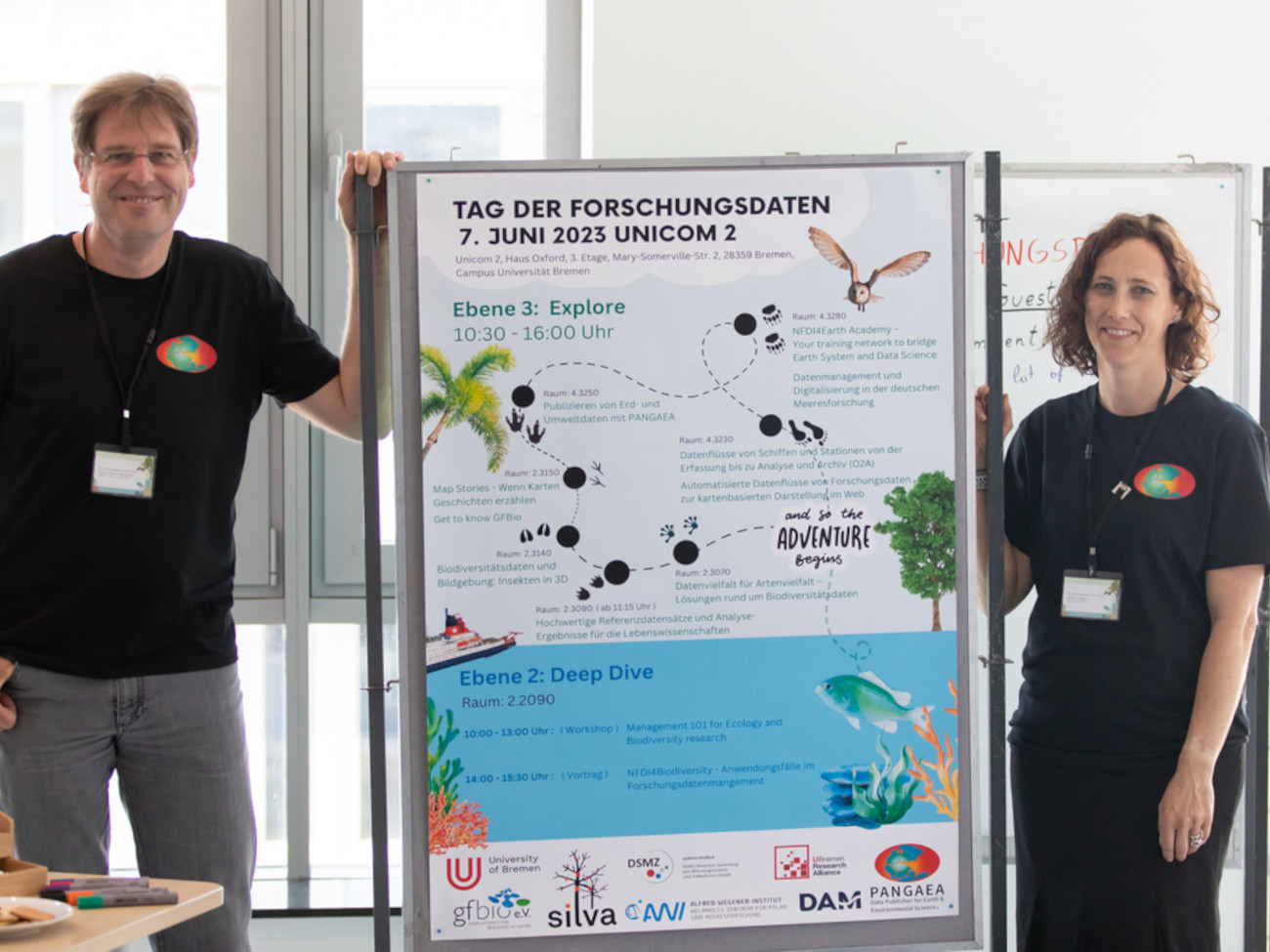
© Jens Lehmkühler
Dr. Frank Glöckner would not disagree. The professor of Earth system data science sported a black T-shirt with the logo of the original continent PANGAEA. The name also stands for one of the world’s most successful digital library systems for data from Earth system research and environmental sciences, which Glöckner leads. PANGAEA has acted as a service provider for science and politics for almost 30 years and is supported by two member institutes of the U Bremen Research Alliance – the Alfred Wegener Institute for Polar and Marine Research (AWI) and the University of Bremen with the Center for Marine Environmental Sciences (MARUM).
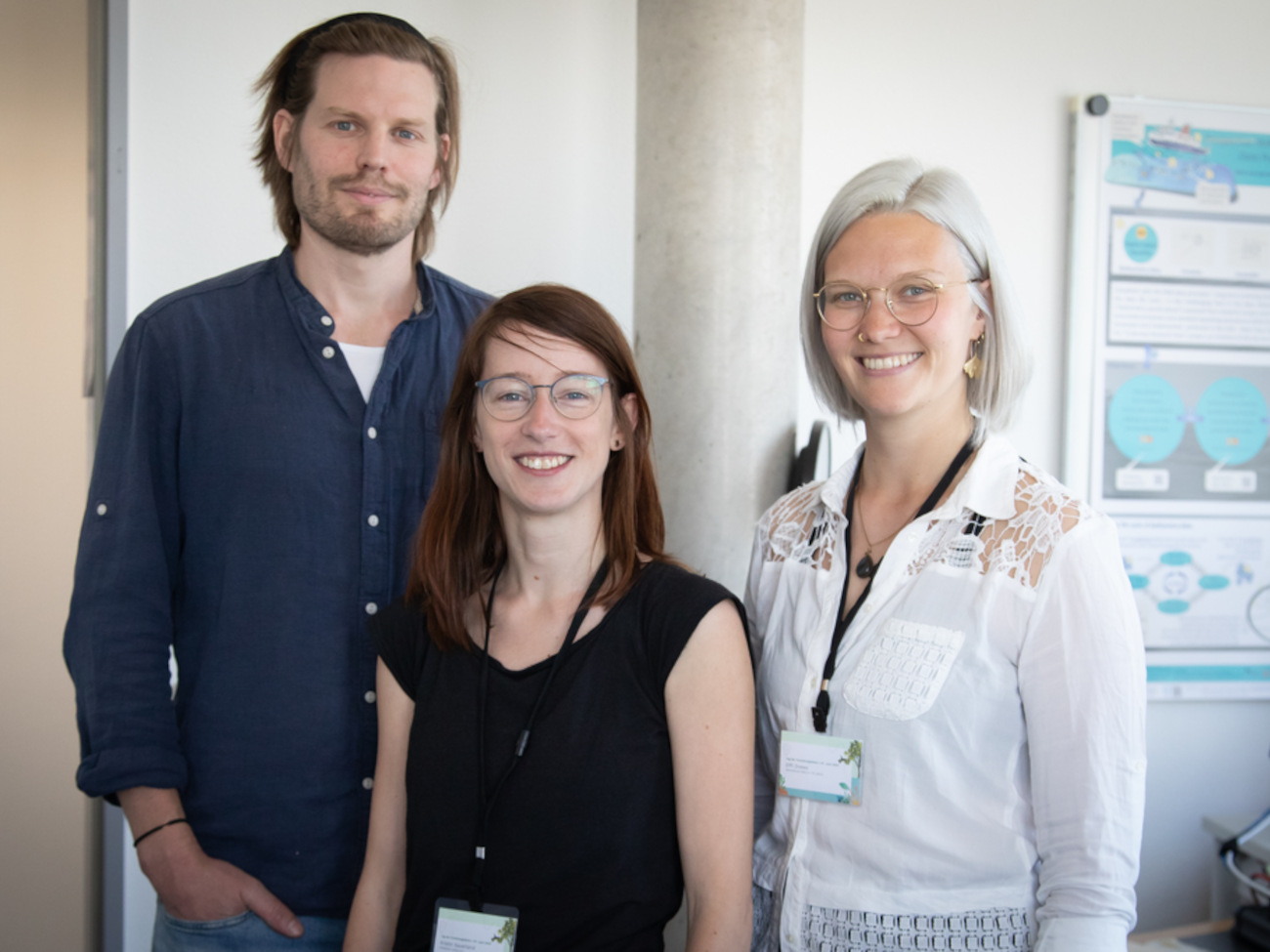
© Jens Lehmkühler
“Collecting and making data available is not an end in itself,” Glöckner emphasized. “This process should lead to better academic science, which then allows for better policy decisions or contributes to better products.” Professor Dr. Hajo Zeeb’s words during the kick-off event reminded of the value of research data in connection with the COVID pandemic. “Without evidence-based data, we would have been lost,” said the director of prevention and evaluation at BIPS, the Leibniz Institute for Prevention Research and Epidemiology. At the beginning of the pandemic, we relied heavily on data from other countries. By now, Bremen has built up a large research archive. Even though there is room for improvement in collecting, connecting, and using research data, “We are now better able to react to future crises.”
“This is why the Research Data Day is so important. It helps to create an awareness that data does not appear out of nowhere, but it does not just disappear either.”
An important building block in working with data is to promote the FAIR-principles that PANGAEA helps to encourage: Data should be Findable, Accessible, Interoperable, and Re-usable. Glöckner admitted that management of research data is not a topic with the greatest sex appeal. “This is why the Research Data Day is so important. It helps to create an awareness that data does not appear out of nowhere, but it does not just disappear either.”
A few doors down in Glöckner’s office in the Unicom 2 building in Mary-Sommerville-Straße 2-4, the products of data collection are exhibited. Life-sized and larger-than-life 3D models of insects are on display. Valuable collections of millions of prepared and pinned insects are stored in natural science museums. “We digitalize insects and create virtual 3D models with true-color surface textures,” explained Lukas Münter from the Society for Biological Data e.V. “Researchers or other interested private individuals can access this data, and make the collections more accessible.”
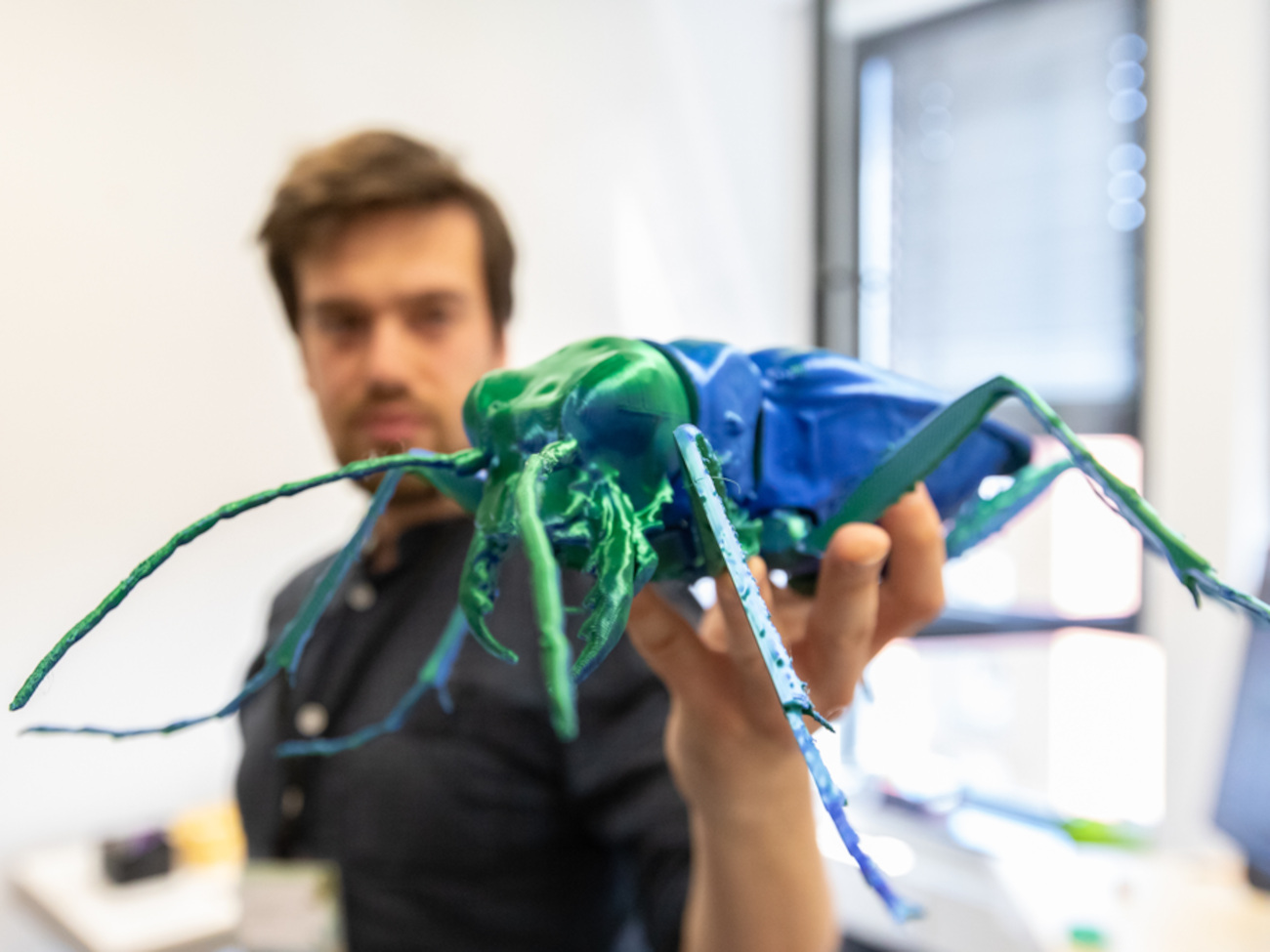
© Jens Lehmkühler
The entire third floor of Unicom 2 was used for displaying projects on the Research Data Day with stickers on the floor showing visitors the way. Accessibility was also a concern for Gauvain Wiemer, head of the core area of data management and digitization of the German Alliance for Marine Research (DAM). The institute is building an integrated data infrastructure for marine research. That could include information from research vessels about temperature, salinity, or current speeds in certain ocean regions, or even the topography of the ocean floor. “Such data is extremely valuable. We are trying to make this accessible in a user-friendly way,” Wiemer explains. DAM also provides information about residual ammunition findings in the North and Baltic Sea.
Dr. Sebastian Vehlken knows his way around such remnants of the two world wars. The professor of knowledge processes and digital media at the German Maritime Museum set up a station with a handheld scanner and screen in the foyer of the University of Bremen’s MZH building, with which visitors were able to create a three-dimensional profile of themselves. Vehlken is convinced of the added value of digital technology for academia and public relations. After all, this is what enables valuable museum artifacts, which up to now have been hidden behind closed archive doors, to be seen by a larger audience.
“We benefit greatly from the exchange with other fields within the U Bremen Research Alliance.”
Vehlken’s primary concern, however, is not individual objects. “Capturing an object with as much photorealism as possible is not as interesting to me,” he said. More important is that the individual objects are linked together and tell a story. That can be the china service on board of an ocean liner on its way from Bremerhaven to America. Who ate from it, who served with it or washed it? “Combined with diary entries, photographs, or maps, we can create a lifelike picture and show an entire world.”
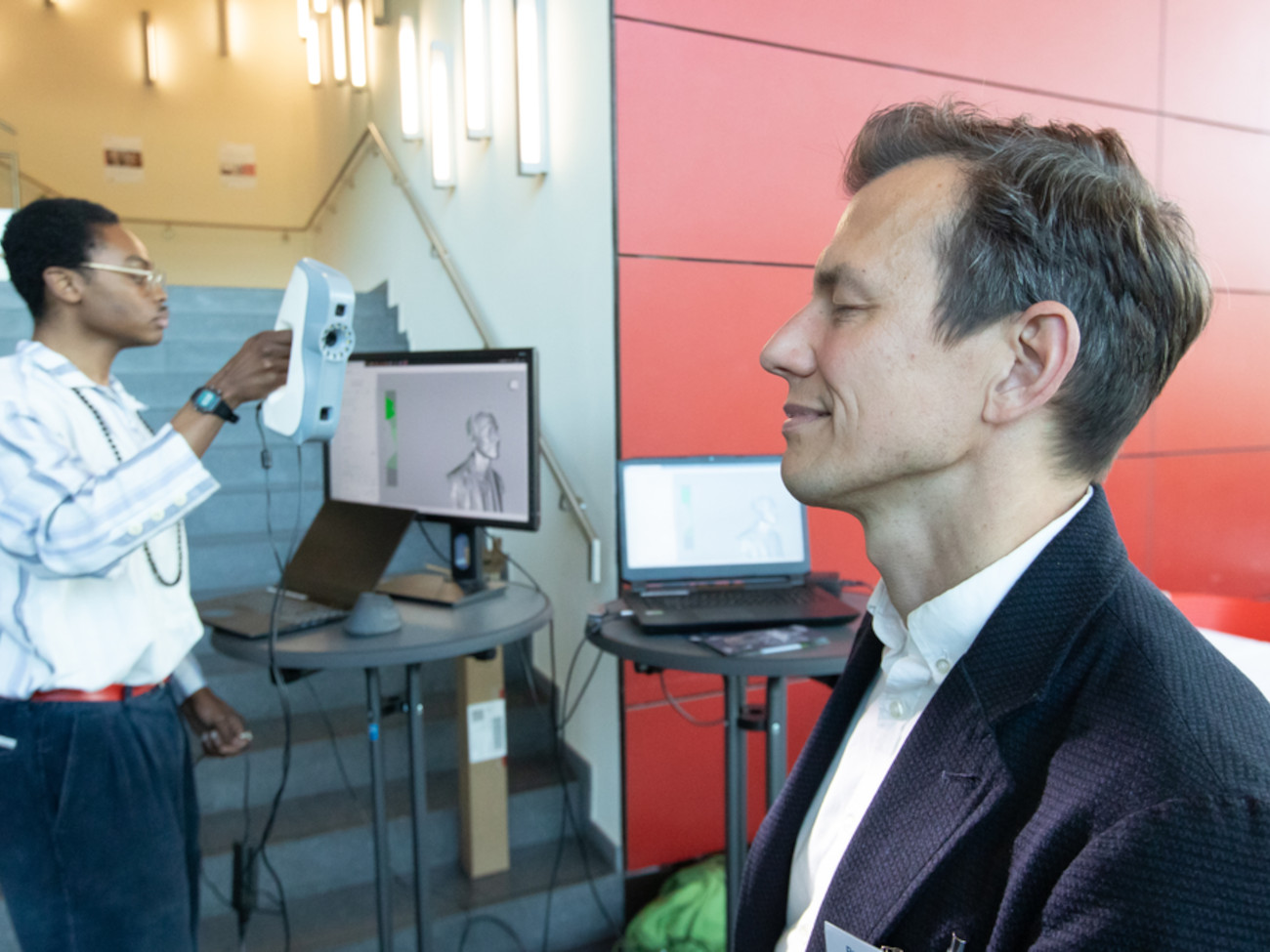
© Jens Lehmkühler
Such digital projects can open the doors for younger visitors, even more so when they are supplemented by interactive elements. Creating these requires a lot of expertise. We benefit greatly from the exchange with other fields within the U Bremen Research Alliance,” Vehlken reports. The German Maritime Museum also values being part of the alliance – and not just on the Data Research Day.
Data stronghold Bremen
The goal of the National Research Data Infrastructure (NFDI) is to systematically develop the data resources of academia and research, to secure them long-term, to make them accessible, and to network them. This will lead to a digital repository of knowledge that will enable new insights and innovations. The Federal Government and the states are supporting this project with a total of 90 million euros between now and 2028. Member institutes of the U Bremen Research Alliance play a leading role in an impressive portion of the consortia, nine out of 27. These include the consortia in the fields of biodiversity, health, social and economic data, engineering, data science, earth system sciences, materials science and materials engineering, microbiology, and the historical sciences.
The article comes from Impact – the U Bremen Research Alliance scientific magazine
The U Bremen Research Alliance is a collaborative organization made up of the University of Bremen and twelve state-funded, nonuniversity research institutes. The cooperation spans four high-profile areas and thus covers everything “from deep sea to outer space.” Twice a year, the scientific magazine Impact provides exciting insights into the results of the collaborative research in Bremen.